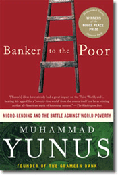"If you go out into the real world, you cannot miss seeing that the poor are poor not because they are untrained or illiterate but because they cannot retain the returns of their labor," writes Muhammed Yunus in his narrative "Banker to the Poor: Micro-lending and the Battles Against World Poverty" (Public Affairs Books, 2003, $15).
The book is a hopeful portrait of the achievements of hard work and passion, which led to Yunus' 2006 Nobel Peace Prize. Vivid details resonate on the most human, intimate levels and unknown laborers become real people: "A woman squatted on the dirt floor of the verandah, a half-finished bamboo stool gripped between her knees. Her fingers moved quickly, plaiting the stubborn strands of cane. She was totally absorbed in her work." Despite a few unnecessary personal tangents and the inevitably dry descriptions of the bank's business model, the book follows a fluid trajectory and remains engaging throughout.
The seeds for Grameen Bank started shortly after Yunus' native country, Bangladesh, won its independence from Pakistan on Dec. 16, 1971. The bloody battle that precipitated independence left the country's economy in shambles, and Yunus knew he had to leave his assistant professorship in the United States and return home. After a brief stint on the government's indifferent Planning Commission, Yunus took a position as head of the Economics Department at Chittagong University. During this time he became involved with development projects in the neighboring rural village of Jobra. The projects were successful from a development perspective, but often provided little assistance to the very poor.
Yunus and his university students began investigating the work habits of these impoverished villagers. They discovered many individual artisans who were caught in a borrowing cycle. Because they never turned enough profit to afford the raw materials by themselves and lacked the collateral needed for commercial bank loans, the laborers were forced to borrow from unscrupulous moneylenders.
Deeply troubled by their dilemma, Yunus wanted to help these workers break free from their cycle of debt. Yunus loaned a total of $27, which a student distributed among 42 individuals documented as debtors. He knew his strategy was a quick fix, and soon began formulating an institutional response for combating poverty.
Yunus eventually began teaming with traditional banks to establish loan programs for the very poor in rural villages, and named the new bank Grameen, meaning "rural" in Bengali. Though initially the banks had to receive operational oversight from commercial banks, Grameen's mission and methodology is fundamentally different from traditional banks. Grameen Banks are microfinance institutions, which lend small amounts of money at high (20 percent at Grameen) interest rates. Grameen seeks to foster entrepreneurial impulses and confidence among the impoverished by providing manageable repayment schedules and a commitment to working with the communities' needs.
Perhaps most importantly, Grameen believes in the innate ability of each individual and sees training as a waste of time. Despite the unilateral approach, Grameen's current loan repayment rate is 98 percent, and the program has been successfully adapted for areas as varied as the Phillippines, Latin America, Arkansas and Oklahoma. Although Grameen achieves many successes, at each expansion Yunus was met with opposition from aid workers and colleagues because of his hard-line, non-traditional approach, and the project has had difficulties expanding in both the United States and Europe. Yunus glosses over the comparatively different government philosophies and legal structures—like usury laws forbidding Grameen's high interest rates, and income caps for welfare—in many western nations that serve as barriers for microfinance. Many participating in microfinance programs in these nations are actually doing so illegally.
Yunus' belief in the individual's innate talent is admirable, but I find his opposition to training a little headstrong. Many of Yunus' clients are skilled in one trade, which they have been practicing for years. If interest in these products wanes, if the individual becomes physically unable to continue the same practices or if crops are wiped out by natural causes, the poor often have no other skills to rely on.
The greatest potential for the success of microfinance and its goals is to combine forces with already existing aid structures and programs. The United Nations and other NGOs provide beneficial development programs—training and expanding infrastructure, among others—even if ending abject poverty is not their primary goal. Acknowledging these realities does not deny the strengths of microfinance; it merely realizes that for systematic reasons, a multi-tiered approach might be the best solution for finally eradicating poverty.



Comments
Use the comment form below to begin a discussion about this content.
comments powered by Disqus